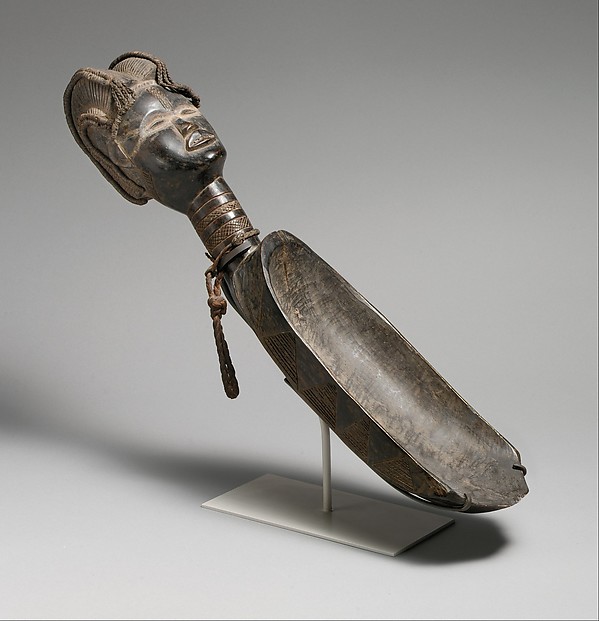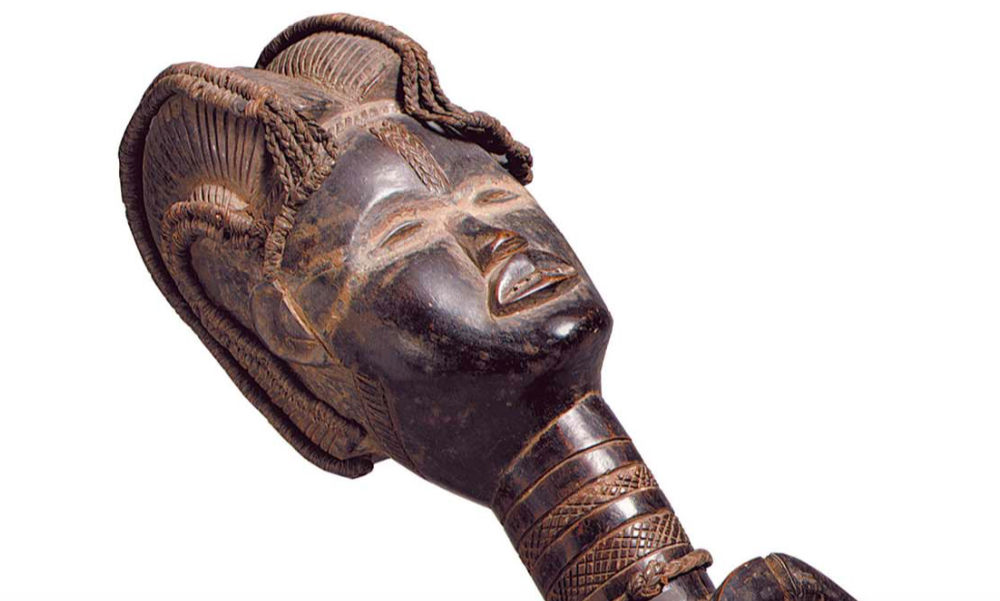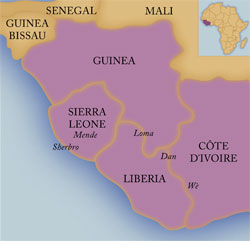
Zlan of Belewale, Ceremonial Ladle (Wakemia or Wunkirmian), before 1960 (Dan peoples, Liberia), wood, fiber, metal, and pigment, 13.3 x 58.4 cm (The Metropolitan Museum of Art, New York)
Among the We and neighboring Dan peoples, large, sculpted ladles like this one are created to honor women known as wunkirle, a title earned through their exceptional generosity and hospitality. This title is bestowed upon one woman from each village quarter who has demonstrated outstanding abilities as an industrious farmer, a bountiful provider of food, and a gracious host. The chosen woman is expected to offer hospitality to all who come to her door at the great celebrations that occur before the planting season begins. As wunkirle, she leads a procession of women carrying pots of cooked rice and soup and directs the distribution of the food to all the guests in attendance. Her duties also include hosting itinerant bands of musicians and entertainers as well as later providing food for men who toil in the fields during the planting season.
Such ladles are carved as an emblem of honor for a particular wunkirle and are typically passed on to the successor she selects to replace her. According to We belief, these ceremonial ladles embody a spiritual force, called dü, which sustains the wunkirle’s exceptional abilities to organize feasts, bringing her great fame and social status. Women who have been honored as wunkirle often accompany male dancers wearing masks in performances. Bearing their ladles in hand, the women dance with the masker, offering gifts and blessings.

Handle (detail), Zlan of Belewale, Ceremonial Ladle (Wakemia or Wunkirmian), before 1960 (Dan peoples, Liberia), wood, fiber, metal, and pigment, 13.3 x 58.4 cm (The Metropolitan Museum of Art, New York)
This ladle takes the form of a long, scooplike bowl surmounted by a handle in the shape of a female head. It is attributed to the artist Zlan, a master carver active during the first half of the twentieth century. The face, sculpted in a style characteristic of Zlan’s work, features slit eyes, a generous mouth with four metal- tab teeth, and a line of delicately incised scarification from forehead to nose. White kaolin clay around the eyes and extending to the sides represents the band of white kaolin clay that Dan women often apply cosmetically to symbolize the heightened powers of sight one must possess to be aware of the spiritual realm. A carved coiffure of two large crescents extending front to back is embellished with plaited fiber along the central ridges. On such ladles, the sculpted head is believed to be a portrait of the original owner of the ladle, whose individuality is conveyed through details of specific scarification and coiffure design features, rather than physical likeness.
Zlan’s work was much sought after by wealthy patrons in Dan, Mano, and We villages in Liberia and Côte d’Ivoire. The son of a carver, Zlan was born around the turn of the twentieth century in a We town on the River Cess, which forms a border between Côte d’Ivoire and Liberia. Zlan’s early demonstration of artistic talent was recognized and encouraged by his mother, who gave him his first adze. He secured his first commission for a sculpture around the age of thirteen and eventually gained widespread recognition for his masterful carvings, many of which now grace museum collections in the United States and Europe.
Until his death sometime before 1960, Zlan served as a mentor to many students during their apprenticeship, establishing his village of Belewale as a major center of carving. According to the recollections of locals, Zlan was often assisted in carving by his wife Sonzlanwon, who blocked out forms in the wood for Zlan to finish. The tradition of carving has continued in Zlan’s family, at least through the late 1980s, carried on by his nephews Wrudugweh and Blekwa as well as a niece, Ziate.
© 2006 The Metropolitan Museum of Art, New York (by permission)
Additional resources


